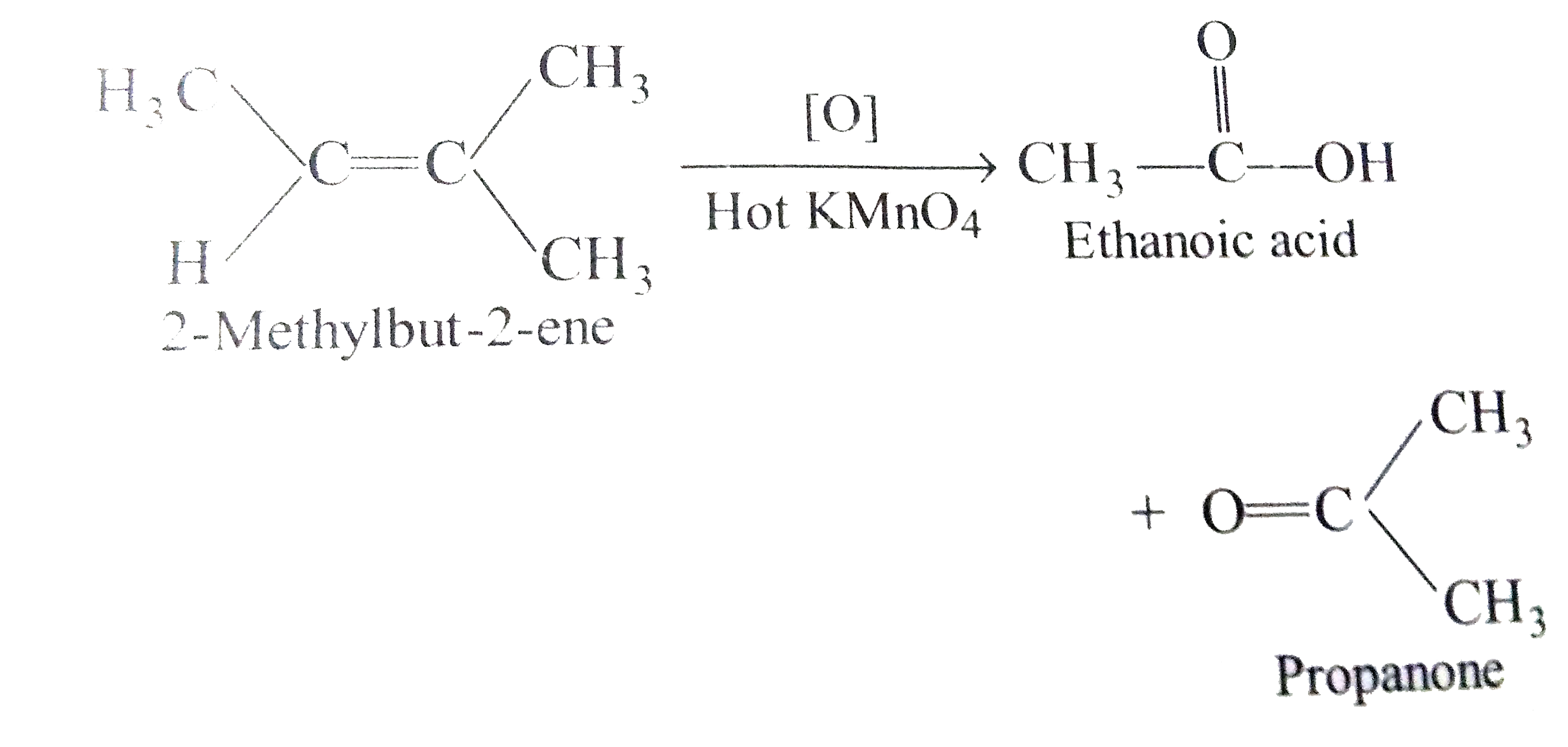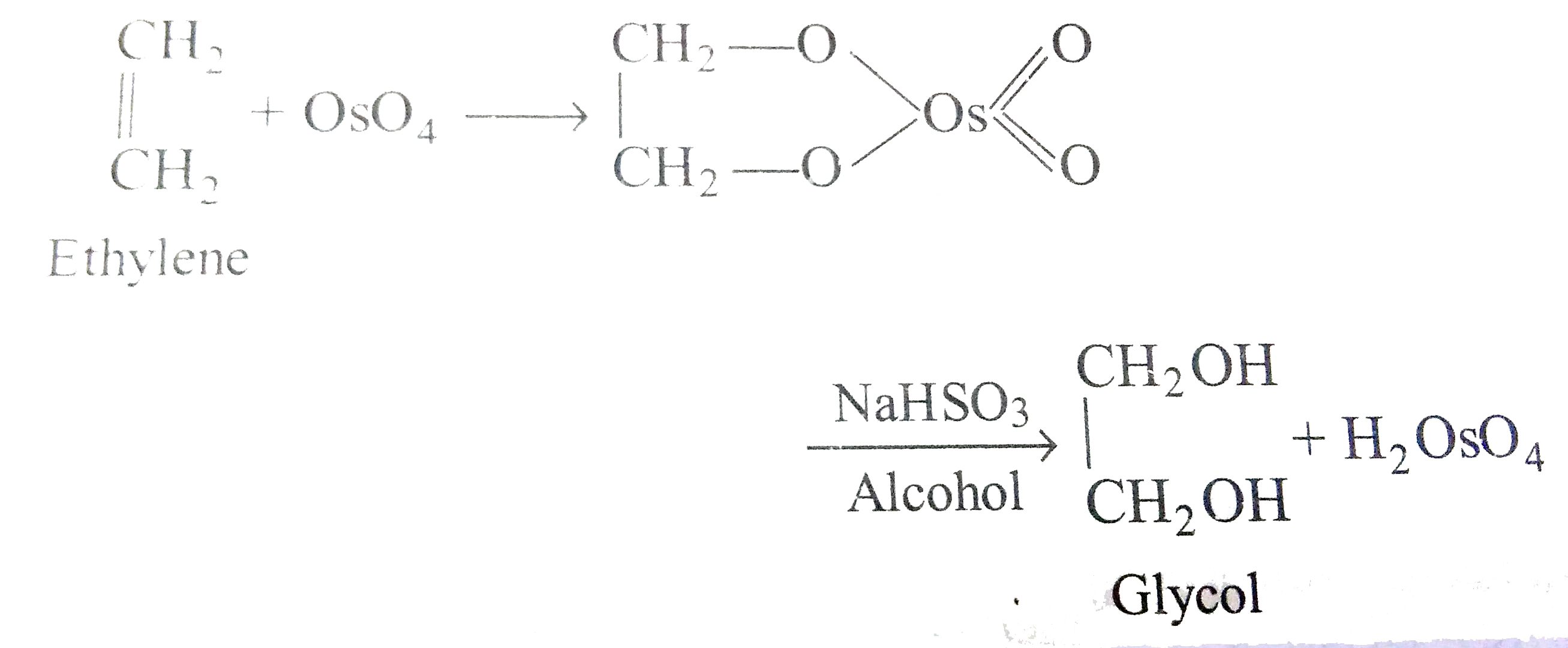Oxidation of alkenes by cleavage with the acidic or alkaline of acidic at higher temperature yields products depending upon the nature of alkene. A hot solultion of is a strong oxidising agent which gives only ketones and carboxylic acids and not aldehydes (as they cannot be isolated).

Oxidation of alkenes with followed by alcoholic or yeilds glycols.

Answer the following questions:
Which of the following compounds on treatment with , followed by will give cis-2-methyl butan-2,3-diol?
2-Methyl-2-butene
4-Methyl-2-pentene
2,3-Dimethyl-2-butene
2,2-Dimethyl-2-butene
The correct Answer is:A
Step by step video, text & image solution for Oxidation of alkenes by cleavage with the acidic or alkaline KmNO_(4) of acidic K_(2)Cr_(2)O_(7) at higher temperature yields products depending upon the nature of alkene. A hot solultion of KMnO_(4) is a strong oxidising agent which gives only ketones and carboxylic acids and not aldehydes (as they cannot be isolated). Oxidation of alkenes with OsO_(4) followed by alcoholic NaHSO_(3) or Na_(2)SO_(3) yeilds glycols. Answer the following questions: Which of the following compounds on treatment with OsO_(4), followed by Na_(2)SO_(3) will give cis-2-methyl butan-2,3-diol? by Chemistry experts to help you in doubts & scoring excellent marks in Class 12 exams.
Updated on:21/07/2023Topper's Solved these Questions
- UNSATURATED HYDROCARBONSBOOK - OP TANDONCHAPTER - UNSATURATED HYDROCARBONSEXERCISE - SINGLE INTEGER ANSWER TYPE QUESTIONS
10 Videos
- UNSATURATED HYDROCARBONSBOOK - OP TANDONCHAPTER - UNSATURATED HYDROCARBONSEXERCISE - MATRIX MATCH TYPE QUESTIONS:
6 Videos
- STOICHIOMETRY (CHEMICAL FORMULAE AND EQUATIONS )BOOK - OP TANDONCHAPTER - STOICHIOMETRY (CHEMICAL FORMULAE AND EQUATIONS )EXERCISE - SELF ASSESSMENT
11 Videos
Similar Questions
Oxidation of alkenes by cleavage with the acidic or alkaline KmNO4 of acidic K2Cr2O7 at higher temperature yields products depending upon the nature of alkene. A hot solultion of KMnO4 is a strong oxidising agent which gives only ketones and carboxylic acids and not aldehydes (as they cannot be isolated).

Oxidation of alkenes with OsO4 followed by alcoholic NaHSO3 or Na2SO3 yeilds glycols.

Answer the following questions:
An alkene 1-methyl cyclohexene on oxidation with hot basic KMnO4 gives:
View SolutionAlkaline KMnO4 and acidified K2Cr2O7 are :
View Solution
Knowledge Check
Oxidation of alkenes by cleavage with the acidic or alkaline KmNO4 of acidic K2Cr2O7 at higher temperature yields products depending upon the nature of alkene. A hot solultion of KMnO4 is a strong oxidising agent which gives only ketones and carboxylic acids and not aldehydes (as they cannot be isolated).

Oxidation of alkenes with OsO4 followed by alcoholic NaHSO3 or Na2SO3 yeilds glycols.

Answer the following questions:
Which of the following alkenes on oxidation with hot KMnO4 gives cyclopentanone?A2-MethylcyclopenteneBCyclopenteneCMethylenecyclobutaneDmethylenecyclopentaneOxidation of alkenes by cleavage with the acidic or alkaline KmNO4 of acidic K2Cr2O7 at higher temperature yields products depending upon the nature of alkene. A hot solultion of KMnO4 is a strong oxidising agent which gives only ketones and carboxylic acids and not aldehydes (as they cannot be isolated).

Oxidation of alkenes with OsO4 followed by alcoholic NaHSO3 or Na2SO3 yeilds glycols.

Answer the following questions:
Which of these compounds on oxidation with hot KMnO4 gives only butanoic acid?AOct-3-eneBOct-4-eneCOct-2-eneD3-Methylhep-3-eneOxidation of alkenes by cleavage with the acidic or alkaline KmNO4 of acidic K2Cr2O7 at higher temperature yields products depending upon the nature of alkene. A hot solultion of KMnO4 is a strong oxidising agent which gives only ketones and carboxylic acids and not aldehydes (as they cannot be isolated).

Oxidation of alkenes with OsO4 followed by alcoholic NaHSO3 or Na2SO3 yeilds glycols.

Answer the following questions:
An alkene 1,2-dimethyl cyclobutene on oxidation with hot KMnO4 gives:A4-ketopentanoic acidB2,3-diketo cyclohexaneChexane-2,5-dioneDethanoic acid and butanoic acid
Which of the following on oxidation with alkaline KMnO4 followed by acidification with HCl gives benzoic acid ?
View SolutionWhich of the following on oxidation with alkaline KMnO4 followed by acidification with HCl gives benzoic acid ?
View SolutionWhich of the following on oxidation with alkaline KMnO4 followed by acidification with HCl gives benzoic acid ?
View SolutionWhich of the following on oxidation with alkaline KMnO4 followed by acidification with HCl gives benzoic acid ?
View SolutionWhich of the following on oxidation with alkaline KMnO4 followed by acidification with HCl would give benzoic acid ?
View Solution
